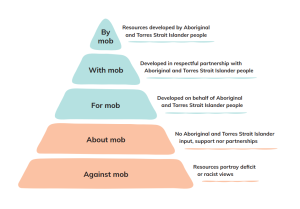7 Evaluating the information
 Learning Outcomes
Learning Outcomes
After completing this chapter you should be able to:
- evaluate the relevance of a resource based on its content, topic keywords, and source for academic use
- assess the reliability of various resource types
- understand how publication dates affect the credibility of resources
- identify whether a resource has been peer reviewed
- consider whether resources which include Indigenous Knowledges respectfully include Indigenous ways of knowing, being and doing
Evaluating resources
As you research or study, you will come across a variety of resource types which may differ in opinions, facts, or perspectives. To guarantee that your assessments include reliable information, you may need to do some evaluation to ensure the information is suitable for your purposes (e.g. assessments) and from reliable sources. With practice, you will become familiar with authoritative authors, key resources, and the communication styles commonly used in your discipline or field of study.
RRR Test
Most resources can be evaluated by applying the 3Rs test. Ask, is the source:
- relevant
- reliable
- recent?
If a resource meets these criteria, then it may be useful for your assessment[1]
 Relevant?
Relevant?
The resource must be closely related to the topic you are researching. This may require some reading of the information to determine whether it is suitable for your needs (tip: try reading the abstract, introduction, and conclusion to gain an overall idea of the information included). You can also look at the keywords or tags for the resource to determine the topic’s relevance.
Evaluating where the resource was published may give an indication of its relevance. Publications from specialised journals focus on a particular field or subject are more likely to provide information directly related to your research topic. You can find a list of journals, databases, books, and related resources in the subject specific library guides. Your myReadings list is a good place to start your research, as your unit assessor will curate this list based on its relevancy.
 Reliable?
Reliable?
The source of the information plays a key role in determining a resources reliability and/or credibility. Consider what kind of publication your source is and who wrote it. Can you find the author and publisher? Is it a government website? Is the article from an academic journal? Is it from Wikipedia? Is it from a personal blog? The quality of these types of resources differ as some are authored by researchers and professionals, while others can be written by anyone, even anonymously, online. Higher quality resources are more likely to include credible information and adhere to ethical practices and are therefore more appropriate for use in assessments.
You may also want to consider if the publisher or author has any biases, such as any political, financial, or personal biases that could influence the objectivity of the content. It’s important to critically evaluate whether the information presented is balanced and supported by evidence to ensure it is trustworthy and reliable for academic purposes.
 Recent?
Recent?
Another point for evaluating resources is the publication date. While this is not the only important factor, it may indicate that the information is the most recent research on the topic. Using the best available research ensures credibility, accuracy, and academic integrity, and enhances your ability to produce well-supported evidence-based assessments. For example, if you were researching the current local water quality, you would attempt to find the most recent sample records. This can be applied to any research topic.
It may also be useful to evaluate the date of the resources cited by the author/s of your resources by looking at the reference list to decide whether they have cited the most recent evidence. An article can appear to be legitimate, but the information may be outdated if the author does not use the most recent research in the writing.
Note that later publication dates can also be useful for comparisons or providing historical context in your assessments, therefore it is important to consider all 3R’s in your evaluation.
Adapted with permission from Studying in the Science: How to evaluate sources of information [PDF 131KB] by The Learning Experience Team, The Learning Zone. © 2024 Southern Cross University.
Other evaluation tests
- IFLA How to spot fake news [PDF 426KB]: IFLA has made this infographic with eight simple steps to discover the verifiability of a given news piece in front of you.
- SIFT (The Four Moves): Stop, Investigate the source, Find better coverage, Trace the original context.
Peer review
Peer-reviewed or refereed journal articles are the mainstay of academic research. Peer review is the process where experts in a particular field review the work of others to ensure that it is suitable quality for publication. This means that we can trust that peer-reviewed resources are of a high standard. The most common type of peer-reviewed resource is scholarly journal articles.
Your unit assessor may require you to include only peer-reviewed journal articles in your assessment, so it is important that you can assess whether individual resources have been through the peer review process.
Here are some tips on finding out if your resource is peer-reviewed:
- When searching in the library catalogue, does the record have a peer-reviewed icon?
- When searching within a database, does it allow you to restrict your search to peer-reviewed publications using a filter?
- Search the web for the home page of the journal. Look for an information for authors/contributor’s page, does it feature their peer review process?
- Search a specialised database such as Ulrichsweb (SCU log-in required) for the journal title. Add the journal’s name or ISSN and look for a black and white referee jersey symbol next to the journal to confirm peer review.
Also, remember to check that your article is scholarly and not just an opinion or commentary piece that has been published in a peer-reviewed publication.
Some good indicators that it is peer-reviewed are:
- the author gives their academic qualifications and/or affiliations with a university
- often includes an abstract
- substantial document (longer than two pages)
- scholarly style writing with a balanced, evidence-based approach
- the resource has a reference list.
Evaluating websites
During your study there may be times when you need to search outside of the library’s resources to find supporting materials for your research or assessments. Using Google or another search engine will return results from a multitude of websites that differ in opinions, facts, or perspectives and range from credible to unreliable.
When using websites for academic purposes, there are some indicators to consider when sourcing information from websites. Use the infographic below for some tips on how to evaluate a website.

Wikipedia – should you use it?
Wikipedia is not considered reliable because content can be written, posted, and edited by anyone. Therefore, taking information directly from a Wikipedia page to use for an assessment is not recommended.
There are some ways that Wikipedia can be useful for your studies though. Wikipedia may be useful to gain an overall understanding of a topic, similar to the way you would use an Encyclopedia to find definitions and important concepts and terms within topics. This may help you develop search terms to expand your research. Wikipedia articles usually have a reference list for their sources, which can include peer reviewed academic articles. You can follow these reference list links to credible sources to use for your research. It is not advised to use Wikipedia as a citation.
Evaluating First Nations resources
Students and researchers should carefully evaluate resources that discuss Aboriginal and Torres Strait Islander histories, cultures and perspectives to ensure that they are accurate and respectful to avoid misrepresentation or bias. This careful evaluation promotes cultural safety and reduces the potential for harm to Aboriginal and Torres Strait Islander people and their communities.
The Indigenous Knowledge Attribution Toolkit[2] provides a decision-making structure for deciding whether a resource is appropriate for use. Consider the following:
Content
- Does the source use outdated or racist terminology?
- Is it contemporary?
- Does the source contain information that was collected without informed consent?
- Does the source centre Indigenous ways of being, doing, and knowing?
Authorship
- Is the author Indigenous? Or it is a partnership supported by community?
- Does the author cite Indigenous authors?
- If the author is not Indigenous, are there any Indigenous authors in the field that you could cite instead?
- What is the authors relationship to the knowledge?
You may not be able to tick off every consideration, but this list can help shape the way you think about Indigenous Knowledges resources and whether they are appropriate for use in your assessments. Where possible students are encouraged to use sources that respectfully include Indigenous ways of knowing, being and doing.
Consider the pyramid below, which was developed by the Australian Institute of Aboriginal and Torres Straight Islander Studies (AIATSIS). The pyramid introduces some of the foundational, integrity-based considerations that students and researchers should make when assessing the cultural appropriateness and educational quality of resources.

The pyramid demonstrates the evaluation of resources as a spectrum between more and less appropriate. With a focus on valuing Aboriginal and Torres Strait Islander authorship, perspectives, and partnerships, the pyramid highlights how you can avoid uncritically using racist and culturally inappropriate content.[3] Students should analyse resources about First Nations people to understand what level of authorship, collaboration, or consultation was involved and aim to choose resources which sit within the blue levels of the pyramid where possible.
To learn more about Indigenous Knowledges visit our Indigenous Knowledge library guide.
Evaluating GenAI outputs
Although the use of GenAI may be acceptable (provided it is appropriately acknowledged and is within the limits as defined in the Assessment task), you must still evaluate the outputs of GenAI tools to ensure the information provided is credible and reliable.
GenAI tools have been known to provide responses that sound credible and human-like, but the responses can be inaccurate, false, out of date, and contain biases.
GenAI outputs are created from a range of training data, which may not link back to original information sources or cite the correct authors, publication dates, and other important details. There have also been cases of made-up references being hallucinated by GenAI tools. This happens when the GenAI tool perceives patterns or objects that are non-existent, creating nonsensical or inaccurate outputs. This is why it is important to gather information from credible and reliable sources of information, such as the Library Catalogue, databases, or trusted websites.
Remember, GenAI tools are not search engines or a direct source of credible information. Learn more about using GenAI tools effectively and ethically at university in the GenAI Library guide.
 GenAI Tip
GenAI Tip
GenAI generated content can sound authoritative but may contain outdated, biased, or fabricated information, including false references. Always evaluate and verify key details by consulting peer-reviewed journals and other credible sources. When using GenAI for research, treat it as a brainstorming tool rather than a final source of truth.
The H5P module below is designed to kickstart your critical thinking when using GenAI tools.
- Learning Experience Team. (2024). Studying in the sciences: How to evaluate sources of information. Student Learning Zone. https://www.scu.edu.au/media/scu-dep/current-students/learning-zone/quick-guides/how_to_evaluate_sources_of_information.pdf ↵
- Indigenous Archives Collective, Faulkhead, S., Thorpe, K., Sentance, N., Booker, L., & Barrowcliffe, R. (2023). Indigenous Referencing Guidance for Indigenous Knowledges. Indigenous Archives Collective and the UTS Jumbunna Institute of Indigenous Education and Research. https://www.caval.edu.au/wp-content/uploads/2024/06/CAVAL_Indigenous_Knowledges_Citation_Guide.pdf ↵
- Australian Institute of Aboriginal and Torres Strait Islander Studies [AIATSIS]. (2022). AIATSIS Guide to evaluating and selecting education resources. https://aiatsis.gov.au/education/guide-evaluating-and-selecting-education-resources ↵

